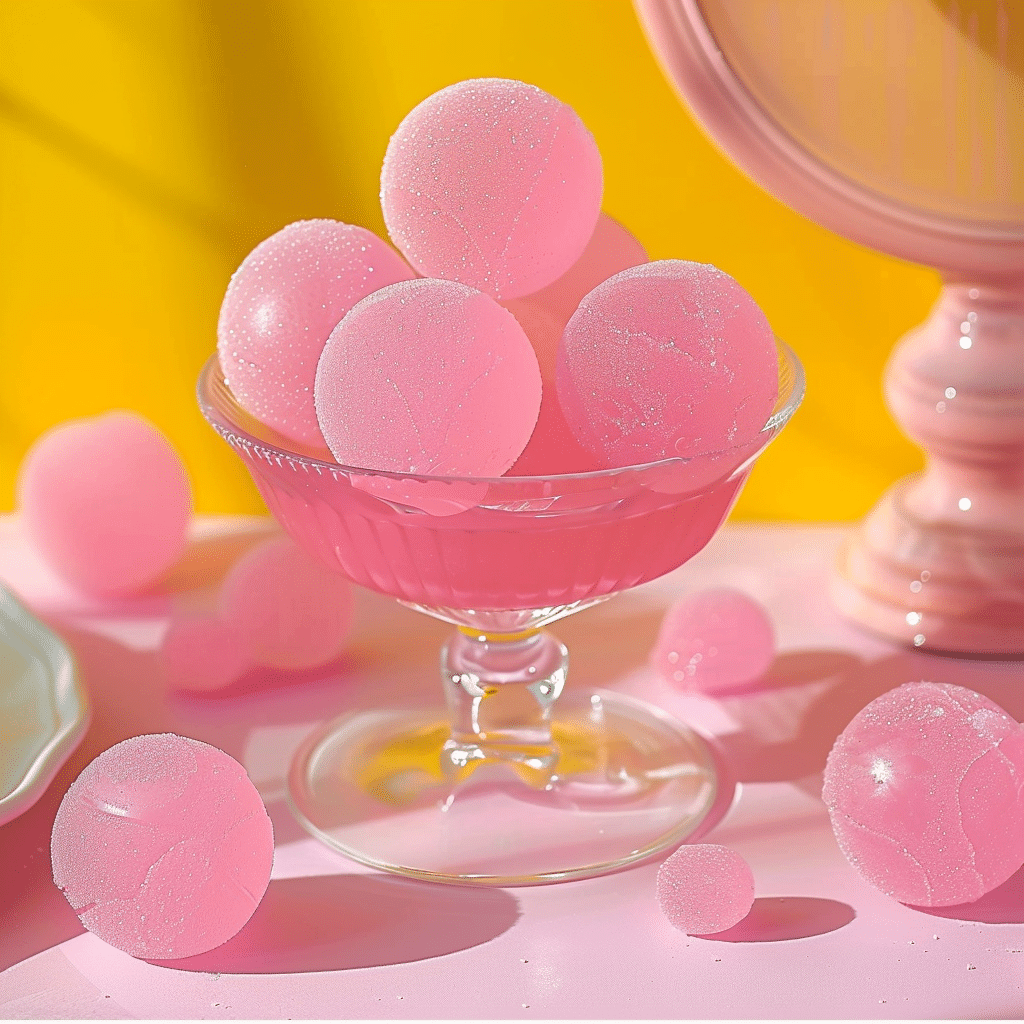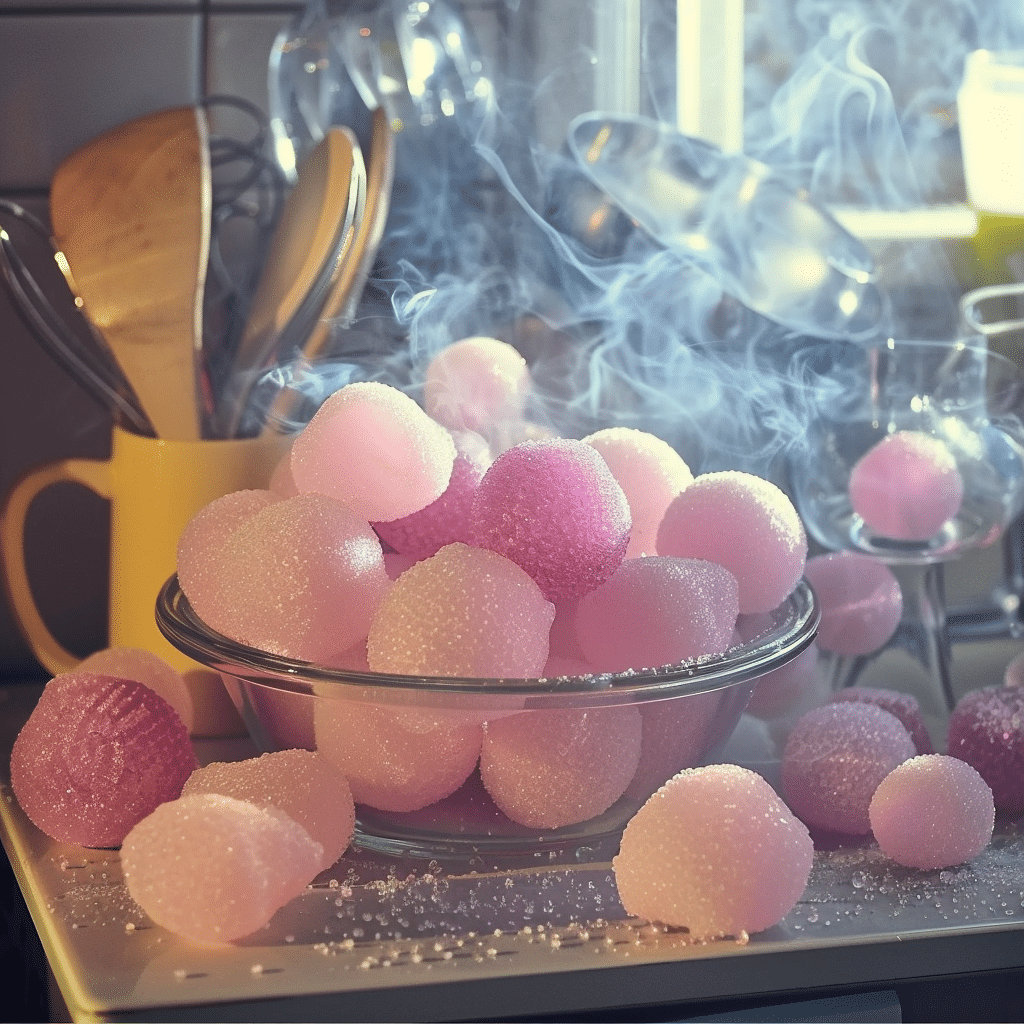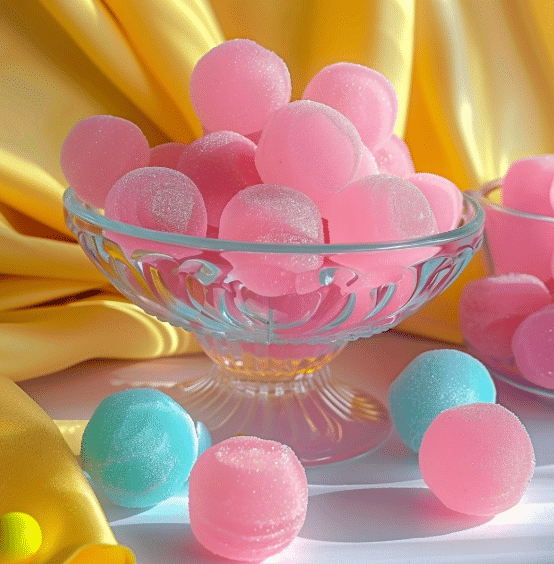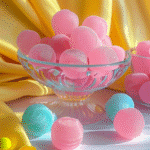Making your own DIY bubble gum at home is more than just a fun activity—it’s a sticky, sweet, and creative adventure perfect for families, candy lovers, or anyone curious about crafting something delicious from scratch. Whether you’re after nostalgic bubble-blowing fun or seeking healthier, more natural alternatives to store-bought gum, this guide has everything you need. From the basic ingredients to mastering the art of bubble blowing, we’ll take you through every step with helpful tips, variations, and flavor ideas to inspire your next candy project. Don’t miss our delicious guide to Gummies & Chews, another DIY candy favorite!
Table of Contents
Table of Contents
1. The Fun and Flavor Behind DIY Bubble Gum
Why Homemade Bubble Gum Is a Trend Worth Chewing
Homemade candy isn’t just for grandmas and bake sales anymore. There’s a rising trend across TikTok, YouTube, and Pinterest where people are diving into DIY candy making, and bubble gum is front and center. Why? Because gum isn’t just tasty—it’s playful, interactive, and surprisingly easy to make at home with the right ingredients.
Making bubble gum gives you total control over what goes into it. No weird preservatives. No hidden chemicals. Just good old-fashioned fun and flavor. Plus, it’s a fantastic group activity. Whether you’re hosting a kids’ birthday party or looking for a kitchen science experiment, homemade gum is a sweet win.
Benefits of Making Your Own Bubble Gum at Home
Why bother with DIY bubble gum when you can buy it at the store? Let’s break it down:
| Benefit | Description |
|---|---|
| Health Control | You choose whether it’s sugar-free, natural, or vegan. |
| Creative Freedom | Add any flavor combo—grape chili gum, anyone? |
| Educational | Learn about food chemistry in a hands-on way. |
| Budget-Friendly | One batch can make dozens of pieces at a fraction of the store price. |
Looking for inspiration? Try our take on Chocolate & Coated Treats for another tasty homemade experiment.
2. Essential Ingredients for Homemade Bubble Gum
A Breakdown of Classic Bubble Gum Ingredients
Whether you’re using a store-bought gum kit or starting from scratch, the typical bubble gum recipe includes a few essential ingredients. Here’s what you need to get going:
- Gum Base: This is the chewy foundation. You can find pre-made gum base online or at craft candy stores.
- Powdered Sugar: Adds sweetness and helps you handle the sticky gum.
- Corn Syrup (or Glucose Syrup): This makes the gum pliable and adds texture.
- Glycerin (optional): Helps the gum stay soft over time.
- Flavoring Oils: Bubblegum, cinnamon, strawberry, watermelon—go wild!
- Food Coloring (optional): For colorful, fun-looking gum.
Each of these plays a unique role in texture, flavor, and chewability. Want to add a natural twist? Swap in stevia and natural fruit juice concentrates for a health-friendly take.
Natural vs Artificial Flavoring in Bubble Gum Recipes
Let’s talk flavor. Artificial flavoring tends to be stronger, cheaper, and more stable—but not necessarily healthier. Natural options are derived from real fruits, herbs, or spices and give your gum a more wholesome edge.
| Flavor Type | Pros | Cons |
|---|---|---|
| Artificial | Long-lasting, stronger aroma | Not health-conscious |
| Natural | Healthier, subtle taste | May fade faster, more expensive |
For example, you can make a DIY mint gum using peppermint essential oil or craft a berry blend with freeze-dried raspberry powder. The key is to experiment!

3. Step-by-Step: How to Make Homemade Bubble Gum
Equipment You’ll Need Before Getting Started
Before you dive in, gather a few basic kitchen tools:
- Microwave-safe bowl or saucepan
- Spoon or spatula
- Rolling pin
- Parchment paper
- Powdered gloves (optional but helpful)
- Airtight containers for storage
These everyday tools will keep things neat and make your gum-making smoother—especially during the sticky stages.
DIY Bubble Gum Instructions: Mixing, Stretching, and Rolling
Here’s the standard DIY bubble gum recipe that works every time:
Ingredients:
- 1/3 cup gum base
- 1/2 cup powdered sugar (plus more for dusting)
- 2 tbsp corn syrup
- 1/2 tsp glycerin
- 5 drops of flavoring oil
- 2 drops of food coloring (optional)
Steps:
- Melt the gum base: In a microwave-safe bowl, add gum base and corn syrup. Heat in 10–15 second intervals, stirring each time until it’s fully melted (about 45–60 seconds total).
- Add glycerin, flavoring, and color: Stir in your optional glycerin, flavoring oil, and food coloring while the mix is hot and gooey.
- Start adding sugar: Slowly mix in powdered sugar. Once it gets too stiff to stir, dump it onto a sugar-dusted surface.
- Knead like dough: Use your hands (with gloves if you like) to knead in more powdered sugar. It’ll be sticky at first, but that’s totally normal.
- Stretch and fold: Keep working the gum until it becomes smooth, stretchy, and pliable.
- Cut and wrap: Use a knife or pizza cutter to slice your gum into pieces. Wrap them in wax paper or place in an airtight jar.
And just like that, you’ve got your first batch of homemade bubble gum!
Don’t miss our full guide on Square Cake Pops for more creative candy DIY fun.
Pro Tips for Better Flavor and Bubble Blowing
Here’s where the magic happens. To enhance your DIY gum-making:
- Add glycerin if your gum is too hard
- Mix flavoring after heating for stronger aroma
- Let your gum rest 10–15 minutes before chewing to improve stretch
- Try cold storage if gum is sticky in warm weather
Want bubbles? The trick is in kneading. The smoother and softer your gum, the easier it is to trap air and blow a bubble. Start small and build up!
4. Best Bubble Gum Alternatives You Can Make at Home
Natural Gum Base: What Are Your Options?
Not all gums are created equal—and if you’re looking for a healthier DIY bubble gum, the base is where it starts. Traditional gum bases often include synthetic rubbers or plastic-like ingredients. But there are natural alternatives worth considering, especially if you’re making gum for kids or want a more eco-conscious recipe.
Natural Gum Base Options:
| Gum Base | Description | Common Source |
|---|---|---|
| Chicle | Traditional tree sap used in early chewing gums | Sapodilla tree |
| Mastic | Plant resin with a mild, pine-like flavor | Pistacia lentiscus |
| Gum Arabic | Used as a binder; adds chewiness | Acacia tree |
| Beeswax | Adds elasticity; ideal for sugar-free recipes | Honeycombs |
Each of these can be sourced online or through specialty candy supply shops. If you’re avoiding synthetics or crafting an all-natural treat, these gum bases are perfect.
Sugar-Free or Vegan DIY Gum Variations
Making your own sugar-free gum is not only possible—it’s easier than you’d think. You simply swap powdered sugar with a sugar substitute such as xylitol, stevia, or erythritol. These natural sweeteners still give your gum its expected taste, without the cavity concerns.
For vegan gum lovers, avoid gelatin-based binders or beeswax and use plant resins instead. Vegan food coloring and essential oils for flavoring are widely available.
Try this quick sugar-free gum variation:
Ingredients:
- Natural gum base
- 2 tbsp xylitol
- 1 tsp vegetable glycerin
- Natural peppermint oil
Melt, mix, and knead like regular gum for a refreshing, guilt-free chew.
Discover great ideas like our Homemade Gummy Bears Guide to explore more natural candy alternatives.
5. Make Your Own Gum Balls
How to Turn Bubble Gum Into Colorful Gum Balls
Turning your homemade bubble gum into gum balls is as easy as rolling dough. Once your gum is fully kneaded and flavored, divide it into small equal-sized pieces and roll each piece between your palms until it forms a smooth sphere. It’s great for visual appeal and portion control—plus kids love the candy-store feel.
Tip: Dust your hands with powdered sugar or cornstarch to reduce stickiness while rolling.
You can even coat them with a candy glaze for that store-bought shine. Here’s a simple way:
Quick Glaze Recipe:
- 2 tbsp corn syrup
- A few drops of water
- Food coloring (optional)
Brush lightly onto each gum ball and let dry for a glossy finish.
Flavor Blending Tips for Fun DIY Combinations
Mixing flavors is where creativity shines in DIY bubble gum making. Instead of one flavor per batch, divide your dough and try layering flavors or swirling colors.
Popular flavor pairings:
- Strawberry + Lime (sour candy vibe)
- Cinnamon + Orange (spicy-sweet)
- Bubblegum + Blueberry (classic + twist)
Want multi-color gum balls? Add a few drops of food coloring to each section and knead separately. Then roll the colored portions into stripes or swirls before shaping them into balls.
Check out Square Cake Pops to learn more about layering sweets in creative ways.
6. The Science of Blowing Bubbles
What Makes a Gum Blow a Bubble?

The real magic of bubble gum isn’t just the flavor—it’s the bubble. But what makes a gum blowable?
The secret lies in the elasticity and plasticity of the gum base. When you chew, the gum becomes more pliable and traps air inside. As you push air through the gum film using your tongue, it stretches outward like a balloon.
To blow the perfect bubble, you need:
- A soft, elastic gum texture (too firm = no bubble)
- A smooth consistency (no graininess)
- Proper tongue pressure and timing
Techniques to Blow Bigger and Stronger Bubbles
Want to be the bubble-blowing champion in your group? Follow these tips:
- Chew for at least 2–3 minutes: This warms up and softens the gum.
- Flatten the gum with your tongue: Create a thin film over the front of your mouth.
- Push air slowly: Rushing will cause weak bubbles that pop too early.
- Keep lips moist: Dry lips cause premature popping.
Troubleshooting Tip: If your gum won’t blow bubbles, it likely has too much sugar or is under-kneaded. Go back and knead the gum longer to achieve a smooth stretch.
Kids love turning gum into competitions—who can blow the biggest bubble? Want more sweet challenges? Don’t miss our fun candy projects like Chocolate & Coated Treats.
7. Fun Flavor Ideas for Custom DIY Bubble Gum
Fruity, Spicy, and Minty Flavor Add-Ins
One of the best parts of creating your own DIY bubble gum is that you’re not stuck with store-bought flavors. You can go wild with combinations or stick to classics—the flavor lab is yours to explore.
Here are popular flavor categories and how to incorporate them:
| Flavor Type | Examples | How to Add |
|---|---|---|
| Fruity | Strawberry, Grape, Blueberry, Banana | Use concentrated flavor oils or freeze-dried fruit powders |
| Spicy | Cinnamon, Clove, Ginger | Add essential oils or ground spices sparingly |
| Minty | Peppermint, Spearmint, Wintergreen | Use natural or artificial mint oils |
When flavoring your gum, a little goes a long way. Start with 3–5 drops per batch and taste-test a small portion. It’s always easier to add more than to tone it down.
Looking for inspiration? Try combining cinnamon with cherry for a “red-hot fruit” twist or blueberry with lemon for a sour pop combo.
Colorants and Toppings That Kids Love
Let’s face it—kids love bright, colorful gum. Adding food-safe colorants makes the DIY experience more fun and visually exciting.
Safe Coloring Tips:
- Use gel or powder-based food colors to avoid thinning the gum.
- Mix before kneading for even coloring.
- Swirl two colors together for a tie-dye effect.
Toppings and Add-Ins:
- Edible glitter
- Candy beads (for crunch)
- Mini marshmallow bits (in gum balls)
Note: Keep toppings small and chew-friendly to avoid choking hazards.
Want more exciting kid-friendly treats? Don’t miss our guide to Candy for Kids for whimsical recipe ideas!
8. Storing, Wrapping, and Gifting Your Bubble Gum
How to Store DIY Bubble Gum for Maximum Freshness
After spending all that effort on your homemade bubble gum, you’ll want to keep it fresh and chewable. Storage matters—improper conditions can harden the gum or weaken the flavor.
Best Storage Methods:
- Airtight containers: Store in glass jars, silicone pouches, or reusable snack bags.
- Cool, dry location: Avoid heat or humidity, which can cause melting or mold.
- Separation with parchment paper: Prevents gum from sticking together in storage.
Well-stored gum can stay fresh for 2–3 weeks, although sugar-free versions may last longer.
For longer storage, freeze wrapped gum balls and defrost at room temp.
DIY Wrapping Ideas for Personal or Gift Use
Planning to gift your DIY gum or prep party favors? These easy wrapping ideas will make your homemade gum look store-bought fabulous:
| Wrap Style | Materials Needed |
|---|---|
| Twist Wraps | Wax paper squares, twist at ends like taffy |
| Mini Boxes | Foldable candy boxes or origami paper |
| Mason Jar Gifting | Add ribbon, sticker labels, and handwritten tags |
This is an excellent opportunity for creative gift-giving—holiday treats, birthday party favors, or even custom candy wedding gifts.
Looking for more inspiration? Check out our guide to Chocolate & Coated Treats for giftable candy ideas.
9. Safety Tips and Cleaning Up After Your Candy Project
Is It Safe for Kids to Make Homemade Gum?
Absolutely—but with some safety supervision. DIY bubble gum can get hot, sticky, and messy, so knowing what parts of the process are kid-friendly matters.
Kid-Safe Involvement:
- Measuring ingredients
- Adding colors and flavors
- Kneading and shaping gum
Adult Supervision Required:
- Melting gum base (very hot!)
- Using essential oils (some are potent or allergenic)
- Cleaning sticky surfaces with hot water
As long as an adult handles the melting process, gum making can be a fun and educational family activity.
How to Clean Sticky Gum from Utensils and Surfaces
The aftermath of gum making often includes sticky bowls, spatulas, and countertops. But cleanup doesn’t have to be a hassle.
Effective Cleanup Tips:
- Soak tools in hot water: This softens hardened gum for easy removal.
- Use baking soda: Sprinkle over sticky spots to scrub without scratching.
- Dish soap + vinegar mix: Cuts grease and breaks down sugar.
Avoid using paper towels—they tend to stick to gum residue. Instead, go for microfiber cloths or dish sponges.
Looking for another sweet and messy project that’s worth every second? Don’t miss our Gummies & Chews guide for more kitchen candy creativity.
FAQs
How do you make homemade bubble gum?
To make homemade bubble gum, melt gum base with corn syrup, then add flavoring and coloring. Mix in powdered sugar, knead the dough, and cut it into pieces. Wrap and store in an airtight container. You can use natural or sugar-free ingredients depending on your dietary preference.
What is a good alternative to bubble gum?
Great alternatives to traditional bubble gum include natural chewing resins like mastic, chicle, or even sugar-free xylitol gum. For people avoiding artificial sweeteners or plastics, homemade fruit taffy or mint-flavored chews are also excellent substitutes.
What are the ingredients for bubblegum?
Typical bubble gum ingredients include:
- Gum base (natural or synthetic)
- Corn syrup or glucose
- Powdered sugar
- Glycerin
- Flavoring oils (like bubblegum or peppermint)
- Food coloring (optional)
Natural variations may use chicle or beeswax for the base and fruit powders for flavoring.
How to make homemade gum balls?
To make DIY gum balls, roll portions of your finished gum dough into small, smooth spheres. Add color and candy glaze if desired. Let them set before storing them in an airtight container or wrapping individually.
How to make gum into a bubble?
Chew the gum until soft, flatten it with your tongue, and push air gently through it to create a bubble. The gum must be elastic and well-kneaded to trap air and expand. Softer textures with a smooth finish make the best bubble-blowing gum.
Conclusion
Making DIY bubble gum is more than just a kitchen project—it’s a creative, educational, and rewarding experience that kids and adults alike can enjoy. From experimenting with natural ingredients to crafting the perfect gum balls, your homemade candy journey opens up endless possibilities. Whether you’re after nostalgic fun, healthier alternatives, or just want to try something new, bubble gum is a delicious place to start.
Looking for your next sweet DIY challenge? Check out our guide to Square Cake Pops for another treat you can personalize and gift with style!
For more recipes follow me on PINTEREST
PrintDIY Bubble Gum: The Sweetest Guide to Making Bubble Gum at Home
Create your own chewy, flavorful DIY bubble gum at home with this easy recipe. Perfect for kids’ parties, nostalgic treats, or creative candy crafting, this gum recipe lets you personalize flavors, colors, and even make your own gum balls. Sweet, fun, and educational—all in one sticky, stretchy bite!
- Prep Time: 10 minutes
- Cook Time: 5 minutes
- Total Time: 15–20 minutes
- Yield: 20–25 small gum pieces 1x
- Category: Candy
- Cuisine: American
Ingredients
-
1/3 cup gum base pellets (natural or synthetic)
-
1/2 cup powdered sugar (plus extra for kneading)
-
2 tablespoons light corn syrup
-
1/2 teaspoon glycerin (optional, for softness)
-
3–5 drops of flavoring oil (bubblegum, mint, or fruit)
-
2 drops of food coloring (optional)
Instructions
-
Melt the gum base: In a microwave-safe bowl, combine gum base and corn syrup. Heat in 15-second intervals until fully melted (about 45 seconds).
-
Add flavor and color: Stir in glycerin (optional), flavoring oil, and food coloring while mixture is still hot.
-
Mix with powdered sugar: Gradually mix in powdered sugar until the mixture becomes doughy and firm.
-
Knead: Transfer to a sugar-dusted surface and knead like dough for 2–3 minutes.
-
Shape: Roll into small pieces or balls. Optional: coat with edible glaze for shine.
-
Wrap or store: Use wax paper to wrap individually, or store in an airtight container.
Nutrition
- Serving Size: 20–25 small gum pieces
- Calories: 30 kcal
- Sugar: 6 g
- Sodium: 1–2 mg
- Carbohydrates: 7 g


